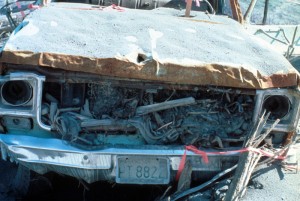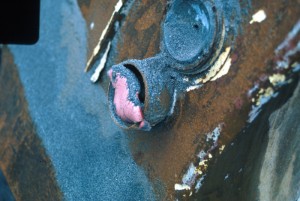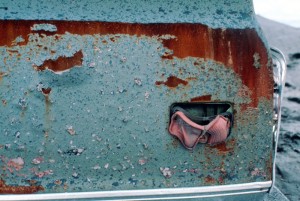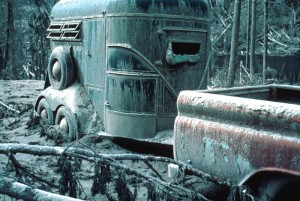In our previous installment regarding the effects of the May 18th, 1980 Mount St. Helens directed blast on vehicles, we learned a valuable lesson. I will call upon commenter Angusum from Boing Boing to sum up: “The main thing we learn from studying vehicles trapped in the path of a volcanic eruption is that you should try very hard not to get trapped in the path of a volcanic eruption.” Indeed. Ah, but I see Pip_R_Lagenta’s hand is still waving: “If we learned anything from Louisiana Governor Bobby Jindal, it is that volcano research is, like, *totally* stupid.” Absolutely. Governor Jindal is completely correct. No need to do any sort of volcano monitoring whatsoever. Volcanoes don’t kill people, people with volcanoes kill people. Or something like that. Anyway, it’s a proven fact if we ignore things, all danger from them magically disappears. Besides, the private sector. And stuff.
Here endeth the snark. Well, mostly. You know how I am. But I’m not being at all snarky when I extend a heart-felt thank you to Maggie Koerth-Baker for featuring our last installment on Boing Boing. Go read all of the comments – they’re wonderful. So are the ones left here. It’s apparent a statistically significant number of you like demolished vehicles. The good news is, I haz moar! And they’re hawt.

See all that lovely damage? To scientists, it’s lovely data. You can’t precisely create a directed blast in the lab – for one thing, people the next lab over may become upset, and for another, I’m not sure we could build stratovolcanoes in the 1980s. Not that I’m sure we could now. But what we did have were auto parts catalogs, forced-air ovens, and silicone oil. Norman Banks and Rick Hoblitt availed themselves of all.
Vehicles in the path of the directed blast suffered some interesting effects. The only really melty bits were plastics. Other bits got hot as well, no denying, but plastics suffered further out than anything else. They melted while sturdier things like automotive paint survived with nothing worse than a good scouring.

Okay. Yeah. That’s no bueno for paint, too. Sure, it didn’t melt off, but that’s small consolation when you have high-velocity winds filled with sand-sized particles blasting the paint right off. But. Color film survived! That’s good. And as long as your vehicle wasn’t in the hottest parts of the blast cloud, your polystyrene insulation made it (does not apply to foam coolers, alas). And, most important to geologists especially, cans of beer lived. Hooray, non-broiled beer!
Field studies of temperature effects on the vehicles showed patterns: to the west-northwest and the northeast, vehicles really got torched. Paint was burned or blistered. Upholstery, fried. Windows, delaminated. Plastics, really melted.

In those directions, it didn’t even matter whether you were at the edge of the down-timber zone: your plastics were toast (well, melted blobs) and your windows delaminated, because what do we laminate windows with? Plastic. And what did the directed blast really hate? That’s right: plastic. Yet your tires and metal bits didn’t scorch. And if you were in the northern or western sector, you might even have been able to read your newspaper afterward – newsprint didn’t scorch. Of course, the news would’ve palled in comparison to what you’d just survived, but at least it was legible.
So what did this say? That things were extra hot in some directions, and that in others, they didn’t even make it to 250°C (482°F) – the charring temperature of newsprint. But how hot was it? Why did plastics take the brunt of the abuse? To the catalog! Or possibly the junkyard – the paper doesn’t specify, but geologists did get their hands on “comparative samples… obtained from vehicles of the same type and year of manufacture as those in the devastated area…” They then took their signal lights, tail lights, and instrument panels, and baked and broiled them in a myriad of ways until they had good standardized data they could use to compare to damage in the field.

What they found was that polymer plastics don’t need to be heated for long or achieve nearly the same level of heat as other materials before they melt. That being so, they melted quicker and at a lower temperature than other substances. They didn’t need the blast cloud to remain hot for long: a decent amount of heat for a short time would do it. This matched what witnesses (and trees) experienced, so the melted plastics were lovely corroborating evidence.
They also allowed geologists to estimate the actual temperatures of the directed blast.

You can see how toasty that northeast sector was. So we have temperatures up to 360°C (680°F) – and some of the bits of rock they found embedded in the plastic may have been as much as 100°C (212°F) hotter. Searing! Plastics out in the open didn’t fare well at all, but if they were at all protected – on the lee side of the vehicle, say, or covered by even things so simple as paper or clothes – they didn’t do badly.
Geologists drilled down a bit, and eyeballed the bubbles left in the melted plastic. Bubbles are useful. They tell you more than you might expect. These bubbles told geologists studying them that peak temperatures passed in as little as one, and certainly no more than ten, minutes throughout the devastated area. Things might have started off blazing-hot, but the temperature of the blast cloud rapidly sank below 150°C (302°F). Which doesn’t sound cool at all, really, but is considerably better than over twice that, a relative spring breeze compared to a blast furnace. Not that most plastics were around to appreciate the balmy temps.

Rubber and metal didn’t have time to get really heated, which meant they survived relatively intact – aside from the sandblasting, battering and all-round pounding they endured. So, yeah. It sort of sucked to be a car in the path of that lateral blast, and as for being a person caught in said cars, well. Let’s just say the only thing that sucked more was being stuck outside a vehicle.
Next, we’ll find out why it super-mega-sucked to be a tree.
Previous: Interlude: When Vehicles Become Part of the Geologic Record.
Next: The Cataclysm: “A Horrible Crashing, Crunching, Grinding Sound.”
References:
Lipman, Peter W., and Mullineaux, Donal R., Editors (1981): The 1980 Eruptions of Mount St. Helens, Washington. U.S. Geological Survey Professional Paper 1250.


“(482°F) – the charring temperature of newsprint.”
We know better! That would be Fahrenheit 451! :-)
Toasty. Yes, that’s a good descriptor.
It’s not really accurate to say that 300C is twice as hot as 150C. If you convert both to the absolute (Kelvin) scale, the increase is about 35%, not 100%.
Of course, in human terms, it might just as well be twice as hot. Neither temperature would be survivable for long.
Loving the dig at Jindal!
Indeed. What a maroon.